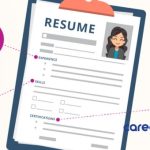Since every job starts with a resume, your goal as a jobseeker is to make the resume compelling enough to convince the prospective employer, that you deserve a chance at an interview.
For a start, you may explore resume templates often used by jobseekers in Singapore.
With the proliferating use of the internet, however, organisations today seek more resource-friendly alternatives — a resume that is online.
How do I make a good online resume for a job?
An online resume is a digital version of its traditional counterpart.
Aside from the mandatory information, such as education and employment history, skills background, and contact information, the digital resume allows you to conveniently direct hirers to work samples, as evidence of your skills to support your resume.
Some examples include articles, photos, and pitch decks.
There are different ways you can make a good online resume for a job:
1. Storing online
Hosting your resume on a document-sharing website is a good start.
You may host your resume and relevant files on document-sharing websites that allow free usage of up to a certain limit.
Instead of a softcopy file, you can provide a link to the resume from the site – common examples include:
- Google Drive
- Dropbox
- OneDrive
Benefits to jobseekers:
- Avoid attachment errors when sending resumes via email or job application sites
- Combine appendices to the resume (i.e. samples of work) instead of sending separate attachments, or include links to samples hosted on the same sharing site
Benefits to employers:
- Instantly view candidate’s resume and work samples in one click instead of downloading multiple files
- Easily send the link to relevant parties in the hiring team for quick viewing
- Access documents on the go
Quick resume tips when storing online:
- Upload your file as a PDF to avoid misalignment issues which often surface in editable formats
- Ensure file size is less than 1 MB for quick loading on any internet browser
- Sign up for a free resume builder to design the resume using a range of customisable templates
2. Creating a resume website
A resume website gives you the flexibility of presenting your professional story with a suite of multimedia features, such as videos, image carousels and audio clips, as well as website elements like drop-down menus, anchor link scrolling and internal/external linking from your resume to work samples.
You can also use a website builder to create a resume and portfolio pages from available templates, for free or with a purchase* (see below) – the latter lets you own a personal domain.
With a website, headhunters can also find you on search engines like Google.
Common examples of website builders for resumes include:
- WordPress
- Weebly
- Wix
- GoDaddy*
- SquareSpace*
Benefits to jobseekers:
- Have pages or page sections dedicated to work experience, academic history, and skills background
- Create a portfolio on the same website
- Provide a single link to all relevant materials required by the prospective employer
Benefits to employers:
- Easily access candidate’s detailed resume and online portfolio in one click
- Bookmark the link and review the updated resume on a later date should the company reconsider the candidate for the role
Quick resume tips when creating a resume website:
- Optimise the website with relevant keywords such as “insurance”, “marketing”, “experienced insurance agent” or “account manager” to improve online search visibility
- Ensure all important information is ‘above the fold’, which is the top quarter to third section of your website that serves as a hook. Information includes your name, designation, experience level, contact information, and a link to your portfolio within the site
Get useful career tips on the go via on Telegram
3. Using social media
Lastly, you can make use of professional networking platforms to establish your resume, with the most common platform being LinkedIn.
Benefits to jobseekers:
- Establish a detailed profile including educational background, latest employment role, and skills
- Request for recommendations from peers
- Connect and network with like-minded individuals to seek job opportunities
- Search for jobs and apply instantly with your profile
Benefits to employers:
- Headhunt for potential candidates with search function
- Connect with candidates and review profiles on a later date for a possible vacancy
- Reduce the need for paper resumes
Quick resume tips when creating a LinkedIn profile:
- Add a well-written summary and review it yearly
- Include a link to resume website and/or portfolio
- Attach work samples for each employment position
- Ensure profile designation is well written (i.e. “Freelance writer looking for projects” or “Experienced HR manager open to work”)
- Write articles on relevant topics directly or indirectly related to your field to display your knowledge level















